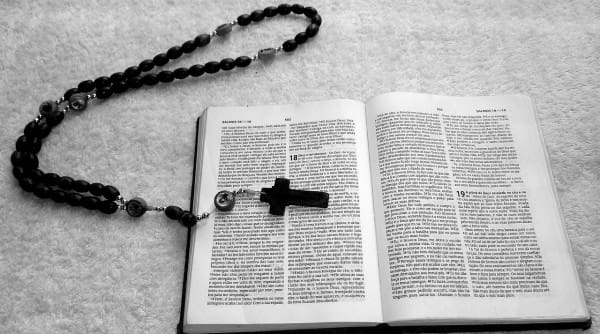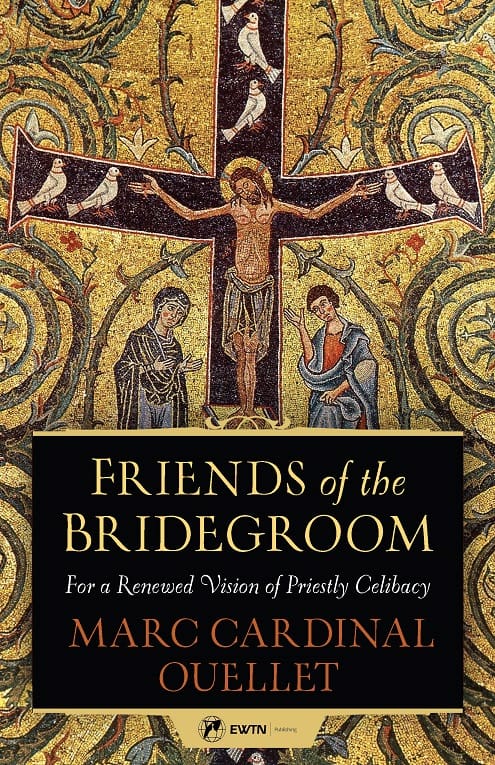An important first step in our reflection is to recall the Trinitarian pattern structuring the opening of the Dogmatic Constitution Lumen Gentium, which describes both the Protagonists of, and the stages in, God’s design. The description begins thus: “The eternal Father, by a free and hidden plan of His own wisdom and goodness, created the whole world. His plan was to raise men to a participation in the divine life.” To this end, He sent His Son, “the image of the invisible God, the first-born of every creature” (Col 1:15), in whom we are predestined to reflect His image (Rom 8:29). And we are to do so in the communion of the Church, which has already been made manifest “by the outpouring of the Spirit” and “at the end of time . . . will gloriously achieve [its] completion.”
Christ, then, came to fulfill the Father’s will. He came to make us the Father’s children by His obedience unto death on the Cross, an obedience that wrought our Redemption and inaugurated the Kingdom of God through His Resurrection from the dead. This Kingdom becomes manifest “as often as the sacrifice of the Cross . . . is celebrated on the altar [and] the work of our redemption is carried on, [for] in the Sacrament of the Eucharistic bread, the unity all believers who form one body in Christ is both expressed and brought about (cf. 1 Cor 10:17).”
Lumen Gentium continues: “When the work which the Father gave the Son to do on earth (cf. Jn 17:4) was accomplished, the Holy Spirit was sent on the day of Pentecost in order that He might continually sanctify the Church, and thus, all those who believe would have access through Christ in one Spirit to the Father (cf. Eph 2:18).”17 “The Spirit dwells in the Church and in the hearts of the faithful, as in a temple.18 In them He prays on their behalf and bears witness to the fact that they are adopted sons. The Church . . . He both equips and directs with hierarchical and charismatic gifts and adorns with His fruits (Eph 4:11-12; 1 Cor 12:4; Gal 5:22).” Finally, “He renews it and leads it to perfect union with its Spouse.” “Thus, the Church has been seen as ‘a people made one with the unity of the Father, the Son and the Holy Spirit.”
Lumen Gentium thus presents the divine plan in Trinitarian sequence: God the Father sends His Son, and the Son’s death and Resurrection, in their turn, inaugurate the gift of the Holy Spirit. Note how this account finds its natural conclusion in a remarkable pneumatological synthesis firmly rooted in Holy Scripture. An important point that emerges in this context is that humanity — having been created by the Father, redeemed by Christ, and sanctified by the Holy Spirit — already participates in, and is destined to rejoice fully in, the communion of the divine Persons.
Christ’s priesthood is an integral part of this Trinitarian plan; it is the central mediation of the divine communion that both constitutes the Church and sets Her up as a “sign” and “instrument” of salvation in the sight of the nations. Before going on to examine the relationship between the two modes of ecclesial participation in Christ’s priesthood, let us first reflect on the theological depths of this priesthood itself and on its relation to the gift of the Holy Spirit. We will approach this question in light of the Trinitarian background we have just sketched.
Let us begin with a fundamental premise that may seem obvious at first but is actually full of sometimes overlooked implications: The priesthood of Jesus Christ is nothing other than His very divine-human being, itself a mystery of Covenant (connubium), seen in its totality as a process of incarnating the Trinitarian Love to the end — that is, the end reached in the Paschal Mystery and the Eucharist. The priesthood of Jesus Christ is not simply one particular item on the list of activities exercised by the Son of God, Who came in the flesh. His priesthood is the redemptive mediation of His incarnate Person, Whose obedience of Love to the point of death and descent into Hell opens to the Resurrection and the gift of the Holy Spirit. Christ’s priesthood is not dynastic, levitical, or institutional, as is the case in other religions or even in the tradition of ancient Israel, where priesthood is based on membership in a caste or on cultic duties of one kind or another. Jesus did not belong to the tribe of Levi, nor did He refer to Himself in the Gospels as a priest — a fact, however, that does not prevent the Letter to the Hebrews from recapitulating the significance of His mission in fully priestly terms. Jesus is a layman who emerges from the prophetic tradition and suffers the lot of the prophets, though His tragic destiny, unlike theirs, ends in eschatological victory with His Resurrection from the dead. “The Gospel of God,” to cite Saint Paul’s solemn words in the Letter to the Romans, “concerns the Son of God, sprung from David’s line according to the flesh, but established according to the Spirit as Son of God in power by his resurrection from the dead, Jesus Christ our Lord.” This Lord Jesus Christ, then, is confirmed by the Holy Spirit as Son of God in power, as victor over death, and as High Priest of the New Covenant. By the same token, the Holy Spirit also confirms the value of Christ’s sacrifice as an oblation of His own blood offered “once for all,” i.e., in such a way as to bring about a definitive liberation and purification. By its very nature, in other words, Christ’s priesthood, crowned as it is by the Gift of the Spirit, is an existential mediation, at once human and divine, that reconciles the world with God and gives it access to the communion that is the Trinity. This gift is communicated to the Church precisely by the gift of the Spirit of Life and Truth. This is why, once the Son has completed His redemptive work, it is now time for the Spirit to enter the scene as Sanctifier, to help appropriating the gift, to recall the gift of the Father and the Son, and to enliven the Church’s faith and life, all as the fundamental Agent of Her participation in the priesthood of Christ.
At this point, however, we must note a particular feature of the relationship between Christ and the Spirit. During the successively unfolding course of Jesus’ life, this relation, this intimate, activepassive connubium and collaboration, undergoes an inversion. The first phase of Jesus’ existence gives evidence of a more active role for the Spirit, to whom Jesus freely submits in obedience to the Father as He follows out the path leading to His Hour. The Gospels, in fact, bear witness that Jesus was “conceived by the Holy Spirit”; that He was driven into the desert by the Spirit; that He was guided and inspired by the same Spirit in His preaching and miracles; and that He was subjected by this Spirit’s help to the supreme test of redemptive obedience, culminating in death on the Cross. “When Jesus had taken the wine, he said, ‘It is accomplished,’ and, bowing his head, he handed over his Spirit.”
At the end of his earthly journey, the incarnate Word’s passivity — or active receptivity — vis-à-vis the Spirit inverts again into an active possession of, and freedom to send, the Spirit that grounded in His, Christ’s, Resurrection from the dead. Standing in the midst of His disciples gathered in the Upper Room on the evening of the first Easter, “he breathed upon them and said ‘Receive the Holy Spirit. Whose sins you forgive will be forgiven them. Whose sins you bind will be bound.’ ” Having been receptive to the Spirit during His earthly life, Christ now becomes an active subject Who sends the Spirit at will, inasmuch as the event of the Resurrection has filled His humanity with the plenitude of the same Holy Spirit.
The difference in the ordering of Christ’s relation to the Spirit before and after Easter, then, is not without importance for His, the very purpose of which, after all, is to glorify the Father by pouring out the Spirit of eternal life upon all flesh. This is why Christ lets Himself be incarnated by the Spirit and remains open to receive Him throughout His earthly journey; it is why He lets Himself be shaped by the Spirit and filled by the Spirit’s fullness, so that, as Lord of the Church and of human history, He might communicate this plenitude without measure. We see, then, a coincidence between Christ’s priesthood and the self-opening of the Trinitarian mystery in His historical and paschal existence: sustained by the Spirit, the Son incarnates His eternal generation in His temporal obedience, which culminates in the supreme Trinitarian moment of His death. Here, the Father glorifies Christ’s obedience by the Spirit, who raises Him from the dead and establishes Him at the same time as Lord of the universe, as Bridegroom of the Church, and as Savior of the human race.
+
This article is adapted from a chapter in Friends of the Bridegroom by Marc Cardinal Ouellet, which is available from Sophia Institute Press.
Art for this post on the priesthood: Cover and featured image used with permission.





